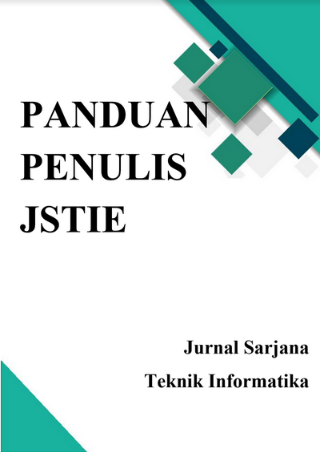Pembuatan Model Customer Relationship Management (CRM) Menggunakan Metode Cobit 4.1 Pada Bidang Perikanan Dan Seksi Budidaya Air Tawar Di Dinas Kelautan Dan Perikanan Provinsi DIY
DOI:
https://doi.org/10.12928/jstie.v6i3.15255Keywords:
Model Customer Relationship Management (CRM), Bidang Perikanan, COBIT 4.1Abstract
Manajemen pelayanan terhadap pelanggan belum bisa memenuhi kebutuhan customer, hal ini menyebabkan pendataan menjadi kurang lengkap, dan akan terhambat dalam pengawasan, monev pelayanan sehingga acuan dalam pengembangan sistem informasi yang mengarah pada layanan hubungan antara Dinas Kelautan dan Perikanan Provinsi DIY dengan customer untuk masa yang akan datang. Hal ini yang mendasari pengukuran dengan menggunakan COBIT 4.1 fokus pada perspektif customer, pembuatan kerangka Customer Relationship Management (CRM) yang dilihat dari sudut pandang proses bisnis dan kebutuhan yang berorientasi pada pelayanan tetapi tidak sampai pada pembuatan aplikasi. Adapun tahapan dalam pembuatan model CRM antara lain analisis customer prespektif dilakukan dengan perhitungan cobit 4.1, pembuatan proses bisnis kondisi saat ini, proses bisnis baru, arsitektur data, arsitektur aplikasi, arsitektur jaringan, pembuatan model CRM, uji kelayakan model dan rekomendasi. Maka diperoleh hasil Kerangka Model CRM di Dinas Kelautan dan Perikanan DIY serta perhitungan COBIT 4.1 yaitu bidang perikanan penilaian. Sehingga dapat memberikan kemudahan dalam berinteraksi dengan customer melalui sistem informasi yang disarankan untuk dikembangkan. Sehingga diharapkan akan penilaian 100% responden menyetujui model CRM yang diusulkan dapat diimplementasikan dan dapat membantu meningkatkan pelayanan khususnya pada Bidang Perikanan serta UPTD BPTPB seksi perikanan budidaya air tawar sebagai bahan acuan dimasa mendatang, sehingga terjalin hubungan yang kondusif dengan customer.References
Ghozali, I., & Handayaningsih, S. (2013). Pembuatan Model Customer Relationship Management (CRM) E-Goverment di Dinas Kelautan dan Perikanan DIY. Yogyakarta: Fakultas Teknologi Industri, Universitas Ahmad Dahlan.
Mufiatun, I., & Handayaningsih, S. (2013). Model Sistem Informasi E-Goverment Menggunakan Kerangka Kerja TOGAF ADM berbasis SOA(Service Oriented Architecture) di Dinas Kelautan dan Perikanan DIY. Yogyakarta: Fakultas Teknologi Industri, Universitas Ahmad Dahlan.
Sudan, R., & dkk. (n.d.). The World Bank. Retrieved from The World Bank:http://www.worldbank.org/en/topic/ict/brief/e-governmen
Indrajit, P. (2006). Electronic Government Konsep Pelayanan Publik Berbasis Internet dan Teknologi Informasi. Aptikom.
Barners, J. (2003). Secret of Customer Relationship Management (Rahasia Manajemen Hubungan Pelanggan),. Yogyakarta: ANDI
Sommerville, L. (n.d.). Software Engineer(Rekayasa Perangkat Lunak) (6 ed.). (H. W. Hardani, Ed.) Erlangga.
Gasperz, V. (2002). Sistem Manajemen Kinerja Terintegrasi Balanced Scorecard dengan Six Sigma untuk Organisasi Bisnis dan Pemerintah. Bogor: PT Gramedia Pustaka Utama.
Leading The IT Governance Community. (2007). COBIT 4.1 Framework Control Objectives Management Guidelines Maturity Models. United Stated of America: IT Governance Institute.
Earl, M. (1989). Management strategies for information technology. New York Prentice Hall.
Standart, O. W. (2011). Business Process Model and Notation (BPMN) Version 2. OMG We Set The Standart.
D.Susanto,Ph.D.,ITIL, T. (2016). Manajemen Layanan Teknologi Informasi. Surabaya: AISINDO.
Downloads
Published
Issue
Section
License
License and Copyright Agreement
In submitting the manuscript to the journal, the authors certify that:
- They are authorized by their co-authors to enter into these arrangements.
- The work described has not been formally published before, except in the form of an abstract or as part of a published lecture, review, thesis, or overlay journal. Please also carefully read Journal Posting Your Article Policy.
- The work is not under consideration for publication elsewhere.
- The work has been approved by all the author(s) and by the responsible authorities – tacitly or explicitly – of the institutes where the work has been carried out.
- They secure the right to reproduce any material that has already been published or copyrighted elsewhere.
- They agree to the following license and copyright agreement.
Copyright
Authors who publish with Jurnal Sarjana Teknik Informatika agree to the following terms:
- Authors retain copyright and grant the journal right of first publication with the work simultaneously licensed under a Creative Commons Attribution License (CC BY-SA 4.0) that allows others to share the work with an acknowledgement of the work's authorship and initial publication in this journal.
- Authors are able to enter into separate, additional contractual arrangements for the non-exclusive distribution of the journal's published version of the work (e.g., post it to an institutional repository or publish it in a book), with an acknowledgement of its initial publication in this journal.
- Authors are permitted and encouraged to post their work online (e.g., in institutional repositories or on their website) prior to and during the submission process, as it can lead to productive exchanges, as well as earlier and greater citation of published work.







